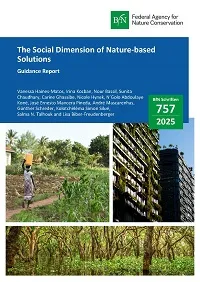BfN-Schriften 757 - The Social Dimension of Nature-based Solutions. Guidance Report
Description
Nature-based Solutions (NbS) have gained global recognition for their ability to tackle environmental challenges while generating social and economic co-benefits. Yet, despite their cost-effective multifunctionality, NbS still face significant operational hurdles. The social dimension that underpins success and long-term sustainability of NbS, remains insufficiently explored. This Guidance Report, developed through the Research & Development BioClimSocial project, aims to address this gap and serve as a comprehensive, practice-oriented resource for researchers, practitioners, policymakers, and funders.
Drawing on literature reviews, a global questionnaire, expert interviews, participatory workshops, and four diverse case studies in Austria, Colombia, Côte d'Ivoire, and Lebanon, the report offers an empirically grounded theoretical and practical framework to clarify and address the social dimension of NbS.
The Guidance Report defines key social aspects of NbS, synthesizes existing guidance while identifying persistent gaps, and presents practical approaches and recommendations to foster meaningful engagement throughout the NbS lifecycle. It illustrates how socially responsive approaches to NbS can enhance legitimacy, long-term effectiveness, and societal benefits, contributing to more resilient pathways for addressing interconnected climate and biodiversity challenges.
